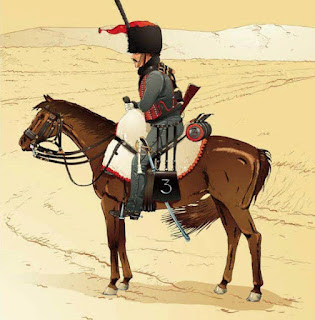The Review!!
a/. From the Introduction.
b/. My minor input.
Two 95th Officers killed on the same horse?
Harry Smith when serving in the Light Division, tells us
that 2 officers in 1/95th, both call Stewart, were killed riding the
same horse and only a short time apart. I
thought this was worth looking into. He
says it took place in March 1811 during the pursuit of Massena out of Portugal. There were 3 officers with the surname
Stewart in 1/95th at that time.
Cpt Hon James H K Stewart, commander of No:1 Coy 1/95th,
he survived the war and seems to have been away on staff postings most of the
time. So not him.
Maj John [Jack] Stewart, commanding the left wing of the Battalion
in the 2nd Brigade, was severely wounded at Casal Nova 14 March 1811
and died 2 days later. As a field
officer he would have been mounted in combat.
Lt James Stewart, Adjutant 1/95th [and possibly
acting Brigade Major in the 1st Brigade], was killed in action at Freixadas
28 March 1811, 2 weeks later. As the
Adjutant, again, he would have been mounted in combat.
So could they have been riding the same horse? I think they could. Because at the time it was customary to
auction off a dead Officer’s possessions with in the Regiment and send the
money home to his family. So Lt Stewart
may well have bought Maj Stewart’s horse that way and been riding it when he
was killed. It would be interesting to
know if the horse was then auctioned off a second time and if anyone dared buy
it?
My 3rd Published Work. 2015.
SAPCOTE AND THE BATTLE OF WATERLOO.
I have always been interested in the battle of Waterloo so, just out of curiosity, I Googled ‘Sapcote men at Waterloo?’ to see if any local men had been at the battle. It was not long before I found the following newspaper article.
The Leicester Chronical and Leicestershire Mercury, Saturday August 12th 1876.
Royal Antediluvian Order of Buffaloes newspaper report.
According to the report there was a J Pratt, of the 7th Fusiliers, wounded at Waterloo. Cross-referencing this with the 1881 census, there was John Pratt, a Waterloo Pensioner, living at 55 Leicester Road, Sapcote. Fantastic, I thought! However, that was easy, far too easy! And just one problem…I know for a fact that the 7th Fusiliers were not at Waterloo!
Extract from the 1881 Census.
Digging deeper into the Waterloo Medal Roll lists, there were [amazingly] three John Pratts at Waterloo: one in the 95th Rifles [one of Sharpe’s Rifles!], one in the 35th Foot and the third in the Artillery. And, as I suspected, none in the Fusiliers. Thus, I searched the Chelsea Pensioner records for Waterloo men, only to find that Rifleman John Pratt is there and he is from Sapcote. However, just to confuse things, there was also a John Pratt, 7th Fusiliers.
The Chelsea Pensioner records give dates and details of service, as follows:
Rifleman Pratt was born in Sapcote in approximately 1769 and first joined the Leicester Fencibles [Militia] in 1795, then the 38th Foot in 1796 and finally the Rifles in 1804. He was wounded at Waterloo [1815] and was pensioned off in 1817 due to his age [48] and poor state of health.
Fusilier Pratt was born in Sapcote in approximately 1796, but did not apply for a pension until 1874, aged 78 when he was struggling as a framework knitter to support himself and his wife [age 75]. He had joined the Fusiliers from the Militia in 1813, and was discharged when the army was reduced in size in December 1818. The exact wording of his pension application is: “slightly wounded in right hip on Baggage Guard on march to Waterloo”.
The regimental history of the Fusiliers states they had been rushed back from America to join Wellington’s army and only missed Waterloo by about two weeks. They were part of the invasion of France and the march on Paris, and were in the army of occupation, not returning home until October 1818. .
Thus, the fact that we now have two John Pratts of Sapcote, both military men, with about a 26 year age difference could be easily explained by them being father and son. It was very common for the eldest son to be named after his father. They are both on the 1841 census, both with families, both framework knitters.
So, only one loose end now: all the records say Fusilier Pratt was born in Sapcote, except the 1881 census [see above] where it says Ireland. The only possible link here could be the fact that the Leicester Fencibles [and so his father], were serving in Ireland around 1796; they were certainly involved in the defeat of a small French invasion force there in 1798. Perhaps by 1881, people were having to take the censuses a bit more seriously and were being more truthful.
Consequently, Sapcote did have a man at the battle of Waterloo and another who could truthfully claim to have been in the Waterloo campaign, even if he possibly exaggerated his actual involvement. It also appears that they were father and son. Quite a story, I think!
Paul Leeson. Sapcote 2015.
Published summer of 2015, in the village magazine for the 200th anniversary of the Battle of Waterloo.
Perfectly proof read by my daughter.
Beautifully typed up for me by my Wife.
Published in English Civil War - Notes and Queries, Issue 20, February 1987.
Original drawing by Stuart Reid for this article.
Stock drawing by G.Ashby.
Both drawings added by the Editor.
Published in English Civil War - Notes and Queries, Issue 20, February 1987.
Original drawing by Stuart Reid for this article.
Stock drawing by G.Ashby.
Both drawings added by the Editor.


















No comments:
Post a Comment